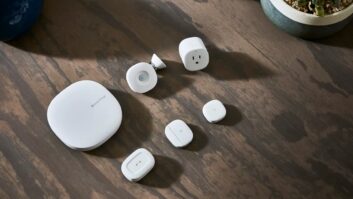DigitalDeck, a Redwood City, Calif.-based start-up, will begin to ship this month, its first multiroom home entertainment network system, based on hard-wired Ethernet cabling.
The system, called the DigitalDeck Entertainment Network, gives users the opportunity to connect numerous analog-based audio and video components in their homes to a network that relays video, music and digital still images back and forth between about three different entertainment stations. As many as five stations have been run successfully in tests, the company said.
The system features a centralized server-like “management unit,” which is called the MX-1000, and a family of satellite terminals called eDecks, which serve as the access and reception points to the network, that are placed in remote rooms tethered by Ethernet CAT-5 cable.
The management unit incorporates a Pentium-level CPU; a 200GB hard disk drive; operating system; and middleware, including application software for a proprietary electronic program guide (EPG), digital video recorder, digital audio player and digital photo viewer.
The first iteration of the system takes analog A/V and S/PDIF digital audio signals. It currently does not handle digital television (DTV) including HDTV signals, although the company said that capability is in the road map for future generations of hardware.
DigitalDeck looks to upgrade its service capability to support DTV and MPEG-4 compression CODECs, as well as Windows Media Player and Windows Media Video sometime after next-generation CPUs are released in 2005, said Marty Levine, DigitalDeck’s strategic development VP.
In the current system, analog and S/PDIF input signals are first run into the eDecks, where they are compressed and encrypted, before being moved around the network as MPEG-2 streams at 6Mbps.
The MX-1000 then intelligently manages the distribution of up to six simultaneous MPEG-2 streams to and from three to five different points in the home.
The system will allow simultaneous playback of multiple programs from multiple devices in multiple rooms. The system software will also allow viewers using multiple entertainment stations to view a single movie simultaneously from different rooms. In addition, any person watching the simultaneously screened program can pause or rewind the program any time they wish at their station without interrupting playback of other viewers in other rooms.
All devices connected to the network can be controlled using a single remote from anywhere in the home. Levine said DigitalDeck has licensed the Universal Electronics IR code database to ensure compatibility with most consumer electronics products. The company is also a licensee of Macrovision and receives electronic program guide data from Tribune Company.
Levine said DigitalDeck uses proprietary EPG technology, which does not use any of Gemstar TV Guide’s intellectual property.
Although the system uses an Internet connection to download guide information and software updates, it does not include an Internet browser for Web browsing.
Levine said DigitalDeck is targeting high-end audiences, initially, and will distribute the product primarily to custom installers. DigitalDeck said it will use Smarthome Inc. to distribute its DDNE products to CEDIA contractors, as well as through print catalogs and an online store.
Levine said a system will be sold in three package configurations. The DigitalDeck Entertainment Network platinum package, which is comprised of four eDecks and an MX-1000 management unit, carries a $5,449 suggested retail price. The gold package, with three eDecks and an MX-1000, carries a $4,675 suggested retail price, and the silver package, with two eDecks and an MX-1000, carries a $3,820 suggested retail price.
Individual eDecks are offered at $859, and the remote control is available for $34.99 each.
“We are going after the high-end market to start,” said Levine. “Specifically, those people who have a lot of equipment already and don’t want to throw it all out in order to control everything.”
DigitalDeck is venture capital funded, with Lexington Capital Ventures serving as the main funding source













